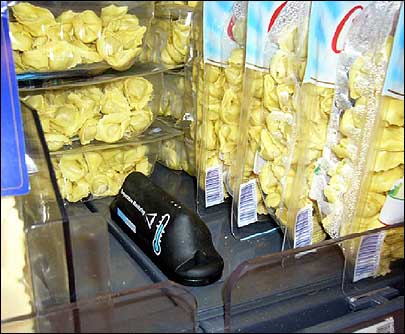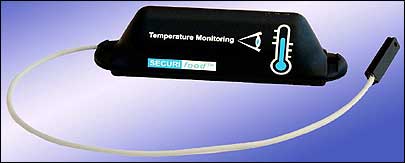Switzerland’s largest retail chain, Manor, is using ultrahigh-frequency (UHF) active RFID tags with built-in sensors to measure and log the temperatures of 1,800 freezers and refrigerators every 10 minutes. A team monitors the fixtures’ temperatures during operating hours at about 30 of the company’s supermarkets across the country.
Starting this month, the team will use the system to track temperatures after hours, when the stores are closed. The company is also developing plans to expand the application so it can track refrigerated and frozen food as it moves from a supplier to Manor’s distribution centers, then on to its retail outlets.
In 2003, Manor sought a way to reduce incidences of food spoiling by not being kept sufficiently cold. Working with Swiss integrator IP01 SA, Manor considered a variety of technologies, such as passive RFID, but ultimately decided on battery-powered RFID tags because of the ease of implementation.
“Freezers unexpectedly turned off, and Manor needed better visibility of the situation in stores,” says Ruud Riem-Vis, IP01’s CTO and founder. “The management in Basel and Geneva didn’t have a clue of what was going on in stores.” Riem-Vis says temperatures dropped when workers forgot to turn on freezers and refrigerators after cleaning them, or to reset blown fuses. “The store managers were ultimately responsible, but sometimes it took too long for them to detect if a freezer went out,” he explains.
What’s more, Swiss laws require that stores monitor temperatures several times per day. Manor sought a system that would eliminate or reduce the effort of this manual compliance task.
The project began with a pilot in 2003 that ran a year and a half at a single store in Neuchâtel, near IP01’s offices. During this time, IP01 and Manor adapted the system, known as Place and Track, to determine the best method for transmitting only critical information, such as unacceptable rises in temperature. Manor did not want to be flooded with data that was difficult to interpret.
Manor and IP01 established various rules so the system would alert operators if specific conditions were met. For instance, alerts are sent automatically if a refrigerator containing fish becomes warmer than 2 degrees Celsius (36 degrees Fahrenheit) or colder than -1 Celsius (30 degrees Fahrenheit).
In addition, the company determined the processes it would go through when using the temperature-monitoring application. For example, Manor decided it would notify store managers rather than department managers, such as the head of the beef department, if the system detected that a refrigerator had stopped working.
At the end of 2004, Manor opted to deploy the technology at 30 supermarkets. IP01 manufactured the hardware and began implementing Place and Track in 2005. The tags consume a maximum of 15 milliwatts to send out their long-range 868 MHz signals, using a custom air-interface protocol designed to minimize battery use. The tags’ lithium-ion batteries, provided by Saft, are guaranteed to last three years. Tags can function at temperatures as low as -35 Celsius (-31 degrees Fahrenheit).
Each tag contains a temperature sensor and a 16-kilobyte memory module able to hold 8,000 temperature readings. The tag is encased inside a triangular plastic housing about 14 centimeters long by 4 centimeters high. The housing comes with a mounting clip that can be slipped into bases installed in refrigerators and freezers. The application requires only a few interrogators since a tag’s signals (consisting of a unique ID number and a temperature reading) can travel a distance of 50 and 200 meters, respectively, inside a store. If the tag were deployed outdoors, its signals could be read at even further distances.
Specially designed RFID readers, which IP01 calls gateways, have been mounted in a store’s ceiling. Every 15 minutes, the gateways forward the tag data they have collected to a server hosted by IP01, which not only designed and implemented the system, but also performs the monitoring services for Manor.
If an alert is serious, IP01 calls stores directly, then enters the actions it has already taken onto a password-controlled Web site that store managers can view. The Web site includes maps of stores indicating the tags’ locations, making it easy for a manager to find the freezer or refrigerator in question. On this same Web site, managers can inform system monitors about their cleaning plans for freezers and refrigerators, to ensure that unnecessary alarms are not generated.
Approximately 1,800 tags are presently in use. On average, Manor receives a total of about 10 alerts per day from the 30 stores using the system, with far fewer alerts received in winter than in summer. Each month, the system generates a report that tallies up alerts generated during that period. These reports have turned out to be an unanticipated benefit for Manor, by providing the retailer with valuable information for making business and operational decisions.
For instance, a store with frequent alerts might be renovated before one with fewer alerts. Another example: Manor discovered that some freezers and refrigerators had mechanical problems, and was able to provide temperature histories to repair technicians to help them troubleshoot those problems.
Starting this month, Manor is using IP01’s monitoring services overnight, and on weekends. After one year, it plans to assess the extended use to determine if it is economically feasible and should be continued.
In addition, Manor intends to work with dairy producer Emmi to expand the system further up the supply chain. Emmi will likely install and test the system by mid-2008. The company ships goods to three Manor distribution centers, and will place an IP01 temperature-sensing tag in one box of yogurt cups stacked with others on a pallet. The tag will not be affixed, but rather placed in a large housing, about the size of a shoebox, so it can be easily located and reused.
A gateway reader installed at Emmi’s manufacturing plant will interrogate the tag as the pallet leaves the factory, and the system will note the time of departure. During transport to the distribution center, temperature recordings will be taken, and a gateway reader will interrogate the tag upon arrival at the DC. Workers will collect the tags and return them to Emmi at a designated time. Only one tag will be used per delivery—no matter how many pallets are shipped—to keep costs down.
When pallets of yogurt boxes are reassembled at the DC to be shipped out to Manor stores, workers will place a different tag in a single box. Upon departure from the DC, the tag will be read again. The tags will then be interrogated upon arrival at the store, and once more upon placement in freezers or refrigerators. Each store has a slightly different layout; some have one gateway to cover tags on the sales floor and at the dock door, while at others, Manor has installed what it calls a “repeater” to make sure all tags can be read. “The repeater is an echo device,” Riem-Vis says, “and it is used in some buildings with thick walls or a metallic environment.”
The tags enable operators to monitor temperatures while goods are being stocked on the shelves, and to calculate how long it took for store employees to put those goods on the shelves. “The critical part is the time between delivery and placement in refrigerators or freezers,” Riem-Vis says. Workers at the receiving store will remove the tag after placing the goods on the shelves, then return it to the DC.
According to Riem-Vis, Manor is reluctant to reveal any financial information, such as ROI or the amount of money it lost annually before installing the system currently in use at the 30 stores. Riem-Vis says the company spent about €100 ($148) per tag, bringing the total cost of tags to about €180,000 ($267,000). In addition, it purchased the gateways used in stores, and pays yearly for the system’s operation. Manor invested roughly €7,500 ($11,100) in equipment per store. The pilot to expand the system to Manor’s DC and a supplier will cost roughly €15,000 ($22,244).
If all goes well, and if the company is pleased with the results of the upcoming pilot involving its distribution centers and Emmi, Manor says it may instruct its other suppliers to implement the RFID system as well.



